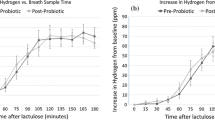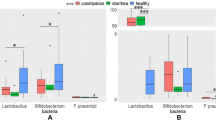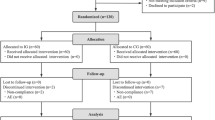Abstract
Our objective was to document how intake of Lactobacillus plantarum 299v affects the concentrations of fecal organic acids during and after metronidazole treatment in 19 patients with recurrent Clostridium difficile-associated diarrhea. Fecal samples were analyzed by gas-liquid chromatography. After intake of metronidazole a significant decrease in total short-chain fatty acids was seen in the placebo group (from 77.1 to 45.5 μmol/g; P=0.028) but not in the Lactobacillus group (79.8–60.4 μmol/g). In addition, a statistically significant difference between treatment groups was noted for butyrate (5.6–1.2 μmol/g in the placebo group vs. 7.6–5.6 μmol/g in the Lactobacillus group; P=0.047). At the end of the study and after cessation of placebo or Lactobacillus, the total short-chain fatty acids rose to the same levels as before antibiotic treatment in the placebo group. Both treatment groups showed a significant decrease in concentrations of succinate at the end of the study in comparison to the time when metronidazole intake was stopped (6.3–1.5 μmol/g in the placebo group versus 9.3–0.9 μmol/g in the Lactobacillus group; P=0.028). The present study of fecal samples from a clinical trial is the first to demonstrate that administration of Lactobacillus plantarum 299v reduces the negative effects of an antibiotic on colonic fermentation. The intake of this probiotic strain may thereby provide an additional benefit for patients with recurrent Clostridium difficile-associated diarrhea.
Similar content being viewed by others
References
Fekety R, McFarland LV, Surawicz CM, Greenberg RN, Elmer GW, Mulligan ME (1997) Recurrent Clostridium difficile diarrhea: characteristics of and risk factors for patients enrolled in a prospective, randomized, double-blinded trial. Clin Infect Dis 24:324–333
Vollaard EJ, Clasener HA (1994) Colonization resistance. Antimicrob Agents Chemother 38:409–414
May T, Mackie RI, Fahey C, Cremin C, Garleb KA (1994) Effect of fiber source on short-chain fatty acid production and the growth and toxin production by Clostridium difficile. Scand J Gastroenterol 29:916–922
Hogenauer C, Hammer HF, Krejs GJ, Reisinger EC (1998) Mechanisms and management of antibiotic-associated diarrhea. Clin Infect Dis 27:702–710
Hove H, Tvede M, Mortensen PB (1996) Antibiotic-associated diarrhea, Clostridium difficile, and short-chain fatty acids. Scand J Gastroenterol 31:688–693
Naaber P, Mikelsaar M (2004) Interactions between lactobacilli and antibiotic-associated diarrhea. Adv Appl Microbiol 54:231–260
McFarland LV, Surawicz CM, Greenberg RN, Fekety R, Elmer GW, Moyer KA, Melcher SA, Bowen KE, Cox JL, Noorani Z (1994) A randomized placebo-controlled trial of Saccharomyces boulardii in combination with standard antibiotics for Clostridium difficile disease. JAMA 24:1913–1918
Surawicz CM, McFarland LV, Greenberg RN, Rubin M, Fekety R, Mulligan ME, Garcia RJ, Brandmarker S, Bowen K, Borjal D, Elmer GW (2000) The search for a better treatment for recurrent Clostridium difficile diasease: use of high-dose vancomycin combined with Saccharomyces boulardii. Clin Infect Dis 31:1012–1017
Wullt M, Johansson Hagslätt M-L, Odenholt I (2003) Lactobacillus plantarum 299v for the treatment of recurrent Clostridium difficile-associated diarrhea: a double-blind, placebo-controlled trial. Scand J Infect Dis 35:365–367
Salminen S, Ouwehand AC, Isolauri E (1998) Clinical applications of probiotic bacteria. Int Dairy J 8:563–572
Sartor RB (2005) Probiotic therapy of intestinal inflammation and infection. Curr Opin Gastroenterol 21:44–50
Ahrne S, Nobaek S, Jeppsson B, Adlerberth I, Wold AE, Molin G (1998) The normal Lactobacillus flora of healthy human rectal and oral mucosa. J Appl Microbiol 85:88–94
Naaber P, Smidt I, Stsepetova, Brilene T, Annuk H, Mikelsaar M (2004) Inhibition of Clostridium difficile strains by intestinal Lactobacillus species. J Med Microbiol 53:551–554
Johansson ML, Molin G, Jeppsson B, Nobaek S, Ahrne S, Bengmark S (1993) Administration of different Lactobacillus strains in fermented oatmeal soup: in vivo colonization of human intestinal mucosa and effect on the indigenous flora. Appl Environ Microbiol 59:15–20
Adlerberth I, Ahrné S, Johansson M-L, Molin G, Hanson LA, Wold AE (1996) A mannose-specific adherence mechanism in Lactobacillus plantarum conferring binding to the human colonic cell line HT-29. Appl Environ Microbiol 62:2244–2251
Mortensen FV, Moller JK, Hessov I (1999) Effects of short-chain fatty acids on in vitro bacterial growth of Bacteroides fragilis and Escherichia coli. APMIS 107:240–244
Rabbani GH, Albert MJ, Hamidur Rahman AS, Chowdhury AK (1999) Short-chain fatty acids improve clinical, pathologic, and microbiologic features of experimental shigellosis. J Infect Dis 179:390–397
Roediger WE (1980) Role of anaerobic bacteria in the metabolic welfare of the colonic mucosa in man. Gut 21:793–798
Scheppach W (1994) Effects of short chain fatty acids on gut morphology and function. Gut 35(Suppl):35S–8S
Mortensen PB, Clausen MR (1996) Short-chain fatty acids in the human colon: relation to gastrointestinal health and disease. Scand J Gastroenterol 216 (Suppl):132S–48S
Johansson ML, Nobaek S, Berggren A, Nyman M, Bjorck I, Ahrne S, Jeppsson B, Molin G (1998) Survival of Lactobacillus plantarum DSM 9843 (299v), and effect on the short-chain fatty acid content of feces after ingestion of a rose-hip drink with fermented oats. Int J Food Microbiol 30:29–38
Johansson M-L, Quednau M, Molin G, Ahrne S (1995) Randomly amplified polymorphic DNA (RAPD) for rapid typing of Lactobacillus plantarum strains. Lett Appl Microbiol 21:155–159
Richardson AJ, Calder AG, Stewart CS (1989) Simultaneous determination of volatile and non-volatile acidic fermentation products of anaerobes by capillary gas-chromatography. Lett Appl Microbiol 9:5–8
Berggren A (1996) Formation, pattern and physiological effects of short-chain fatty acids. Doctoral thesis. Lund Institute of Technology, Lund University, Lund, Sweden
Meijer-Severs GJ, Van Santen E, Meijer BC (1990) Short-chain fatty acid and organic acid concentrations in feces of healthy human volunteers and their correlations with anaerobe cultural counts during systemic ceftriaxone administration. Scand J Gastroenterol 25:698–704
Mellon AF, Deshpande SA, Mathers JC, Bartlett K (2000) Effect of oral antibiotics on intestinal production of propionic acid. Arch Dis Child 82:169–172
Bender A, Breves G, Stein J, Leonhard-Marek S, Schroder B, Winckler C (2001) Colonic fermentation as affected by antibiotics and acidic PH: Application of an in vitro model. Z Gastroenterol 39:911–918
Breuer RI, Buto SK, Christ ML, Bean J, Vernia P, Paoluzi P, Di Paolo MC, Caprilli R (1991) Rectal irrigation with short-chain fatty acids for distal ulcerative colitis. Preliminary report. Dig Dis Sci 36:185–187
Macfarlane S, Macfarlane GT (2003) Regulation of short-chain fatty acid production. Proc Nutr Soc 62:67–72
Acknowledgements
This study was supported by a grant from the county of Skåne. Probi AB Ltd. (Sweden) provided active preparations of Lactobacillus plantarum 299v and placebo. Anna Berggren is employed at Probi AB. The other authors have no financial interest in the company.
Author information
Authors and Affiliations
Corresponding author
Rights and permissions
About this article
Cite this article
Wullt, M., Johansson Hagslätt, ML., Odenholt, I. et al. Lactobacillus plantarum 299v Enhances the Concentrations of Fecal Short-Chain Fatty Acids in Patients with Recurrent Clostridium difficile-Associated Diarrhea. Dig Dis Sci 52, 2082–2086 (2007). https://doi.org/10.1007/s10620-006-9123-3
Received:
Accepted:
Published:
Issue Date:
DOI: https://doi.org/10.1007/s10620-006-9123-3




